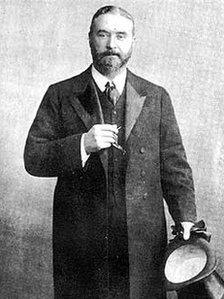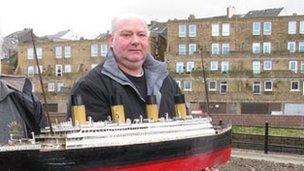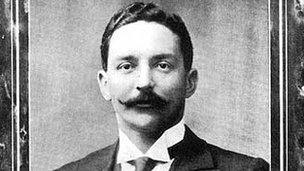The Cumbrian town at the root of Titanic story
- Published

Thomas Henry Ismay was born and learned his trade in Maryport
Visitors come to Maryport to enjoy its fine shoreline or proximity to the Lake District, but most people do not realise the low-key coastal resort is at the root of the Titanic story.
The Cumbrian town is the birthplace and early home of Thomas Henry Ismay who went on to found the Oceanic Steam Navigation Company, more commonly known as the White Star Line.
At the time of his birth in 1837, Ismay's father (also Thomas) ran a timber, shipbuilding and ship brokers business, and his son learned his future trade watching the comings and goings at the port.
Cliff Ismay, his "great grand nephew", said: "It was his childhood days in Maryport which inspired his later life.
"He used to go down to the harbour in all his free time, and knew most of the sailors. They nicknamed him 'baccy Ismay' on account of the tobacco he chewed, even at that young age."
At 16, Thomas Henry became an apprentice to a Liverpool shipping firm and, after serving his time with the company, spent some time developing the Australian wool trade, before going into the shipping business.
Kate Winslet character
In 1866 he acquired a line of clipper ships, sailing to Australia, and set about substituting the wood vessels with new, iron ones.
By the time the White Star Line was formed in 1869, Thomas Henry and his family had moved away from Maryport, but the connection with the town remained.
When the clock on the spire of Christ Church broke, he donated a new one. The family also paid for a stained glass window in St Mary's Church.
The name does live on in the town, which boasts an Ismay Wharf, an Ismay Close and a White Star Way but Cliff Ismay wants the link to be more widely recognised.

Cliff Ismay wants to put Maryport on the Titanic map
The 56-year-old, who lives in nearby Workington, added: "I feel Maryport is at the root of the Titanic story, but a lot of people are unaware of the connection.
"We're trying to put it on the map."
By the time of Thomas Henry's death in 1899 the White Star Line was commissioning the building of the largest and most luxurious ships in the world.
His son, Joseph Bruce Ismay, took over and was instrumental in the creation of what was hoped would be the jewel in the company's crown - the Titanic.
He was a passenger on the liner during its fatal voyage.
'Last lifeboat'
The stories surrounding Joseph Bruce are many but almost all centre on allegations of his cowardice in escaping the sinking ship while fellow passengers, notably women and children, were left to fend for themselves.
In later life he never spoke about the disaster, and when he died in 1937 there was no mention of the Titanic in his obituary.
Cliff Ismay said: "Joseph Bruce Ismay has been harshly treated. His actions shouldn't need defending, but for various reasons they have to be.

Joseph Bruce Ismay was "harshly treated", according to one of his descendants
"He left on the last lifeboat, not the first as is usually portrayed, and it was testified in the inquiry [held afterwards] that there were two empty seats and no women around.
"If he hadn't got into it then no-one else would have been saved.
"The only thing that would have changed is that another life would have been lost."
Cliff Ismay has been the driving force behind an exhibition to coincide with the 100th anniversary of Titanic's inaugural voyage and subsequent sinking.
Held at the Wave Centre, it features a recreation of one of the ship's third class berths, and a replica Marconi Room, where distress signals were broadcast.
It also includes costumes worn by the Kate Winslet character "Rose" in the 1997 blockbuster movie by James Cameron.
Commenting on the film, in which Joseph Bruce is shown leaving on one of the first lifeboats, Cliff Ismay said: "All I'll say is I've seen it once. I don't make a habit of it."